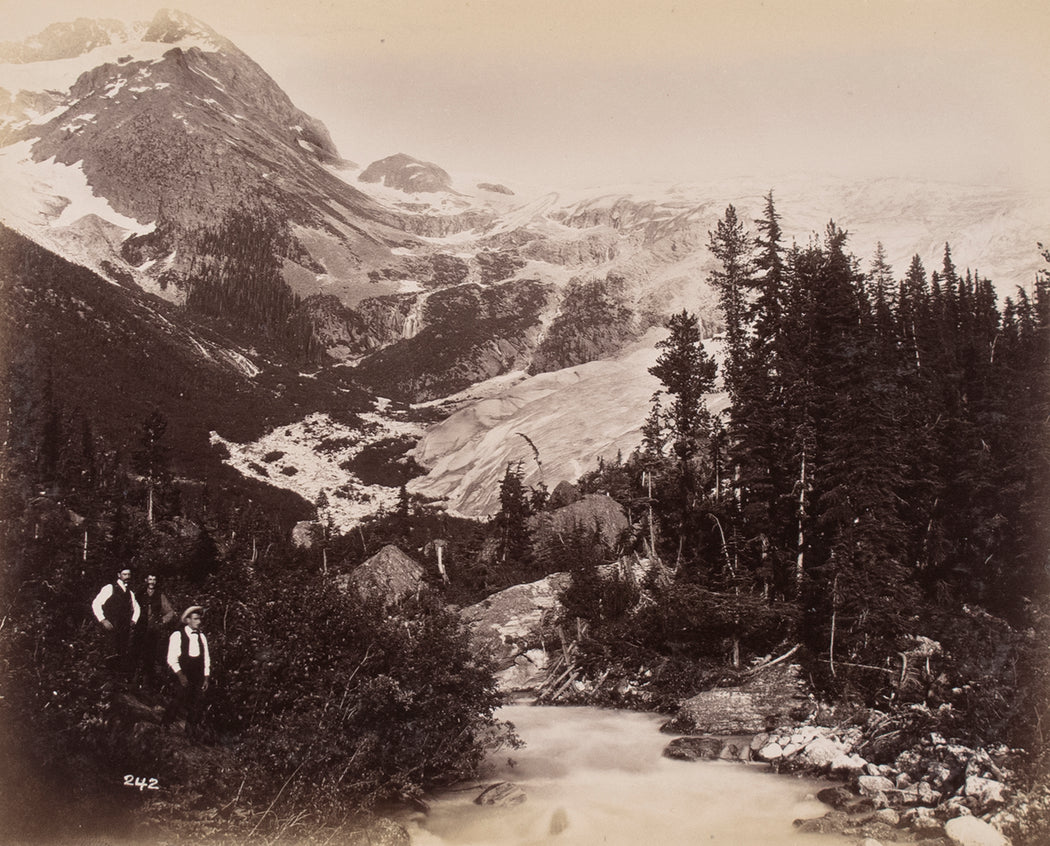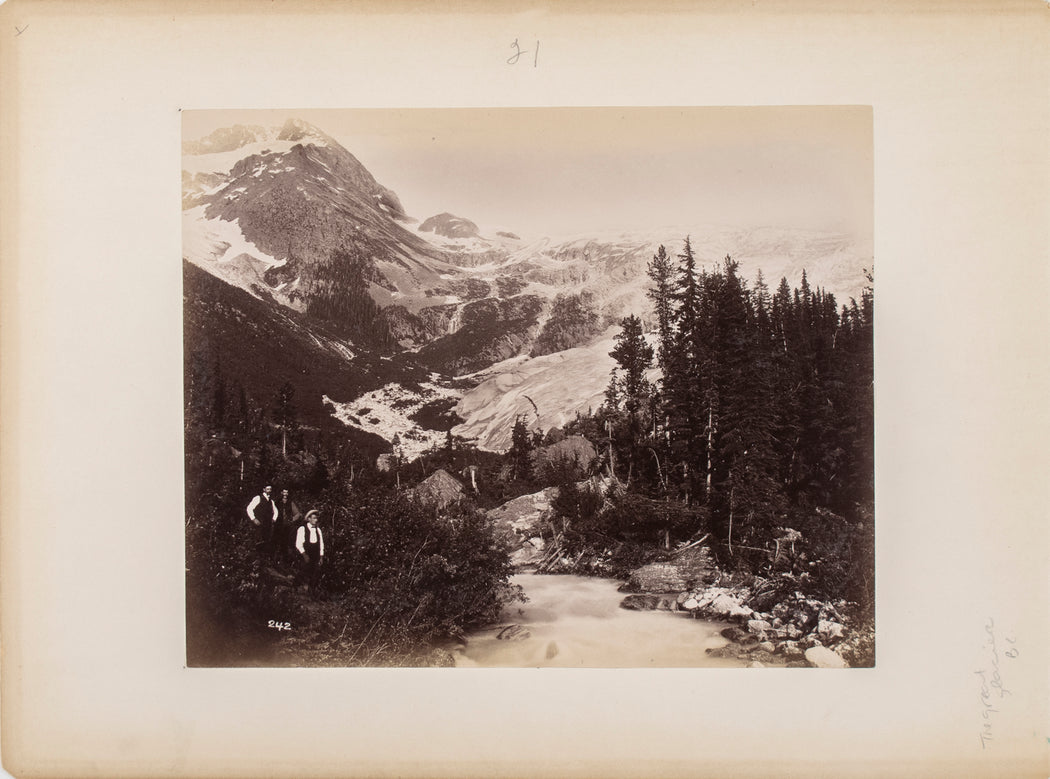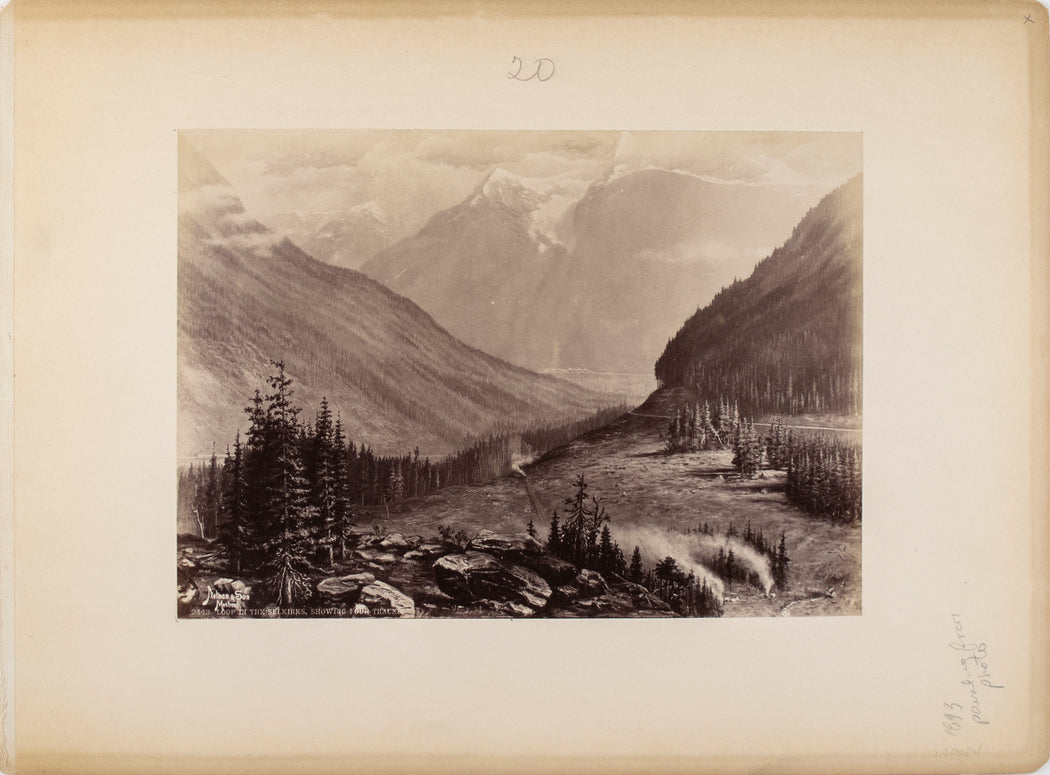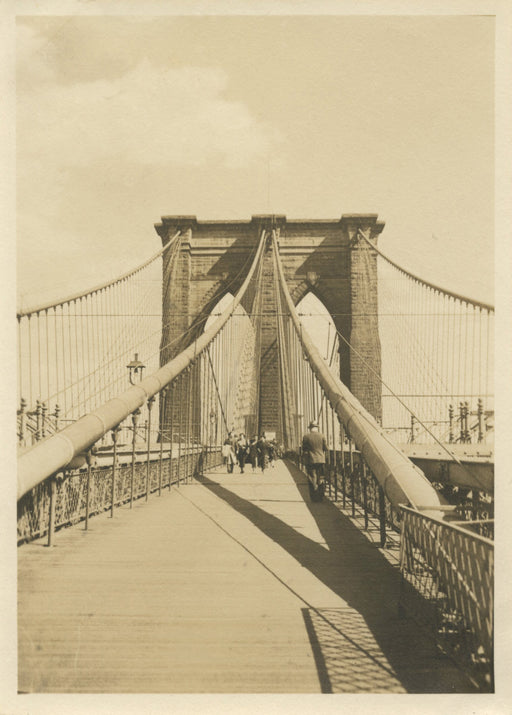



Alexander Barton Thom
The Great Glacier, British Columbia by Alexander Barton Thom
 Toronto, ON)
Toronto, ON)
Learn about our Shipping & Returns policy.
Have a question? Read our FAQ.
- Artwork Info
- About the Artist
-
circa 1897
Albumen print mounted to period board
Annotated “242” as part of the negative, titled and annotated “21”, in pencil, au mount recto
Print titled “2443—Loop in the Selkirks, Showing Four Tracks” and “Notman & Son, Montreal”, printed as part of negative, annotated “1893 painting from photo” and “20”, in pencil, au recto
Printed circa 1897 -
Alexander Barton Thom’s photographic achievements throughout western Canada in the 1880s and 1890s have been described as “among the most artistic and professional in the West for that period,” but biographical information about him has proven difficult to find. Dempsey and Maurice identified him as Adam Bissett Thom, the son of Adam Thom, born at the Red River Settlement [now Winnipeg] in August 1843. However, research now indicates that the photographer A. B. Thom was, in fact, Alexander Barton Thom.
Thom was born at Stratford, Ontario in February 1849, the oldest of six children born to Scottish immigrants John Strathearn Thom (1823-1879) and Elizabeth Barton (1828-1885). His younger brother, John S. Thom Jr., established a general store at Lucan, Ontario where he also dabbled in photography. Perhaps this is where Alexander got his start in the craft. His sister, Mary Gowanlock Thom, was married to Andrew Crawford at Winnipeg in August 1880. Thom arrived in Manitoba sometime in 1880 and in October purchased a lot at Nelsonville, where he intended to open a photography studio in the spring of the following year.
It is unequivocal that, by May 1883, Thom had formed a photographic partnership at Winnipeg with Fred V. Bingham which lasted until 1886. During this period, Thom was primarily an itinerant who spent much of his time travelling in western Canada, taking numerous photographs in the spectacular mountain ranges west of Calgary. During 1886, for example, he took over 2,000 views along the Canadian Pacific Railway route through the Rockies. In December of that year, the results of his latest foray were described thusly: A. B. Thom, the photographer of the C.P.R. has returned to the city [Winnipeg] from the West and is staying at the New Douglas House. He has been engaged for the past six months in taking views along the track through the mountains ... Only a small number have been completed, but there are enough to give one an idea of the wildness and romantic picturesqueness of the country through which our national highway runs. There are a number of views of snowsheds erected during the past summer, and they show them to be built in the most substantial manner. The roofs of some of the sheds are level, in place of slanting, as they are popularly supposed to be; but the impetus with which the avalanches come down the Mountain side carries them over the sheds, even when they are level. One of the views gives a sight of a long tea train doubling one of the loops in the Selkirk. In front of the trainload there is an ordinary engine; but behind there is one of the immense Baldwin consolidated mountain engines forcing the train up the grades. The track runs at the base of a high embankment and disappears; but at the top of the embankment a railway track is seen. It is really a part of the same line, which after two miles had doubled back to within a few yards of itself. This loop is in the Selkirk. There are also views of the town of Rogers Pass, consisting of one street with one storey wooden structures ranged along it; of the Glacier Hotel in the heart of the Selkirks with an impenetrable wall of fleecy ice immediately behind it stretching up into cloudland; of Banff; and of many other points of interest along the route.
Thom visited England briefly in early 1887 to obtain a special lens designed for taking mountain views, which he used from 1887 to at least 1889. During the winters of 1885 through 1889, and possibly later, he spent his winters travelling through the USA and England, giving presentations illustrated with his images. Thom believed the presentations benefitted the Canadian Pacific Railway and immigration to western Canada, and he used this argument to support his request that the railway provide a railway car as a portable photographic studio:During the winter months of the last four years, I have traveled through the Eastern, Southern and Pacific Coast States. Also in England with a large collection of my views and in nearly every place I visited, they were more then [sic] surprised at the fine scenery of this country compaired [sic] with what their imagination led them to think it was. Nothing but mountains of rocks and ice. And by what I have seen and heard I am certain that the passenger business of your company could be greatly increased by liberal system of photo advertisement. One instance of many. I met with an agent of the Burlington and Quincy in Banff last summer. He bought a lot of my views to have framed and put up in his office. In answer to my question, he said if our people knew what this country possessed in scenic beauty or saw my views of it they would certainly include it in their summer tours. If I get as good a chance as other photographers have had by having the use of a car over the road. I would like very much to make a collection of large views 21 in x 25 inches in consideration of my getting that privilege for every year I have the use of a car, I will have framed and place one thousand dollars worth of my views in Great Britain, California, the Eastern provinces and States. Similar to the plan adopted by the Southern Pacific where they have all available space in Stations and Hotels covered with views if it pays American roads to run a photographic car for ten years or more, it would more than do so on the C.P.R. In another year I will have enough of negatives to make a large collection of slides for a stereopticon exhibition. You can see a few of my views in book form in Mr. Whyte’s office if you should visit Winnipeg soon.
Thom’s request seems to have been considered negatively by the CPR, as there is no record of a response in its archival files.
Unlike his former partner Fred Bingham, who had made a permanent move west by the late 1880s, Thom maintained his base of operations in Manitoba. In 1890, he resided at Stonewall (perhaps to be near his widowed sister and widowed mother who lived on a farm in the RM of Rockwood) then at Winnipeg from 1891 to 1894. In 1892, he opened a studio at Carman with a Mr. Pontreath in charge. He had a studio at Regina (Saskatchewan) from 1894 to 1897, and one at Brandon from 1896 to 1900 with a satellite studio on Fourth Street at Wawanesa from 1897.
It appears that, after closing his Wawanesa photography studio in 1904, Thom settled down to the life of a bachelor farmer on a homestead southwest of St. Claude. By 1923, he was living in the Odd Fellows Home, a retirement facility, in Charleswood. He died there on 22 April 1926 and was buried at Stratford, Ontario.
Biography: Manitoba Historical Society




![Untitled [Two women at midway]](http://ffoto.com/cdn/shop/products/Freedman_Untitled_Twowomenatmidway__circa1972_512x.jpg?v=1647967873)

